The exhibition Picasso: Peace and Freedom, at the Albertina 22 September 2010–16 January 2011, showed the twentieth century’s most important painter from a hitherto almost unknown perspective: in cooperation with Tate Liverpool, the Albertina presents Pablo Picasso as a politically and socially committed artist, thereby questioning the common image of this genius of a century. Assembling some two hundred exhibits from more than sixty international collections, the exhibition illustrates within a historical review and in chronological order how Picasso responded to the war and its atrocities in his art. The exhibition’s scope ranged from Picasso as a history painter and his key motif of the Dove of Peace – one of the most important symbols of hope and the most famous emblem of the Peace Movement – to his still lifes, which contain subtle and hidden commentaries on global events, as well as hints of Picasso’s political attitude.
In 1944, Picasso joined the French Communist Party, whose loyal member he remained until his death in 1973. That same year, Picasso set to work on the painting The Charnel House, (below) which marked the beginning of the Albertina’s exhibition. Based on a documentary about the murder of a Spanish Republican family, it is one of artist’s most important paintings protesting against Franco’s regime in Spain apart from

Guernica.
The major global crises of those days – the Spanish Civil War, the Cuban Missile Crisis, the Korean War, and the Algerian War of Independence – run through the artist’s oeuvre like a red thread.
With his liberal paraphrases on this serious crisis of the Roman Empire, Picasso addressed the impending catastrophe of a Third World War and nuclear Armageddon.
To the Algerian War of Independence he responded with his




Women of Algiers, I, 1955
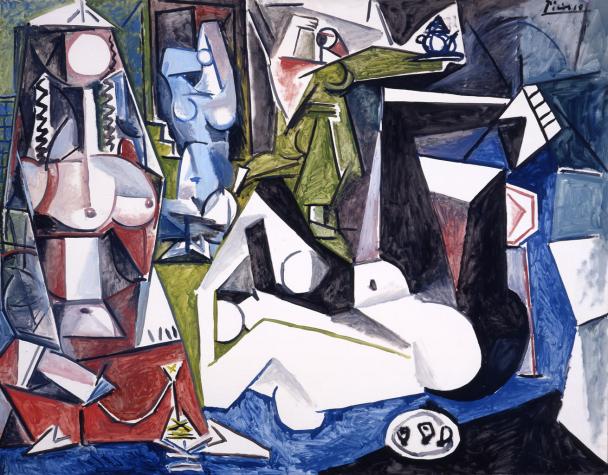
Picasso. Women of Algiers. Variation ''N''
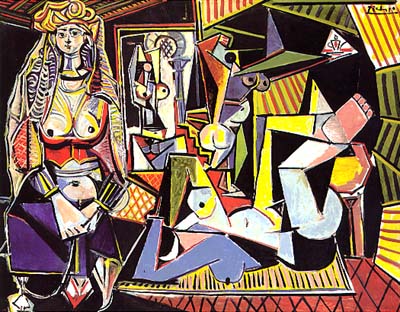
Picasso. Women of Alger, Version ''O''.1955
Women of Algiers series of 15 paintings,
on which he began to work within the first month of this major violent conflict by referring to
.jpg!Large.jpg)
Women of Algiers by Eugène Delacroix.
Whereas Delacroix’s Women of Algiers of 1834 marked the beginning of French colonization in Algeria, Picasso’s variations symbolize the end of the country’s foreign rule.
The Dove of Peace, created in 1949, likewise held prominent position in the exhibition. It became an international emblem used by the Peace Movement and a symbol of hope during the Cold War. Many works by Picasso from that period explicitly served propaganda purposes and were meant to support the Communist cause and the Peace Movement.
“I came to the party as one goes to the fountain.” (Picasso)
For Picasso, who had left his native country of Spain under Franco’s regime and had experienced the Nazi occupation of Paris in his French exile, it was only natural to feel drawn to the Communist Party. He saw Communism and its peace ideal as a means to ban Fascism and in 1944 joined the French Communist Party, whose member he remained until the end of his life. Out of extreme generosity and driven by his conviction, Picasso donated a lot of his time and money to the Communist Party and in addition provided works of art for its purposes. Picasso’s propaganda motifs were extremely valuable for the party: by then an internationally renowned artist, he designed numerous posters and pamphlets and conceived drawings for party-affiliated newspapers if requested.
The Charnel House
Picasso also did highly political paintings, including his monumental work The Charnel House of 1945. Besides horrible images from concentration camps, he had been inspired by a documentary film about a Spanish Republican family whose members had been brutally killed in their own kitchen. The Charnel House was Picasso’s most political work since Guernica. Since he had lost many friends and associates during the war, it was also a way for him to mourn his ‘family’, the Spanish people. The same holds true for his painting Homage to the Spaniards.
Still Lifes
The artist’s numerous impressive still lifes are also expressive of the war and the loss and deprivation it entailed. His contemplations about mortality and the futility of human action reflect Picasso’s own threatened existence, but also his resistance against any form of suppression. Using plain objects of everyday life, Picasso alluded to the hardships and deficits of that period of time. Such traditional vanitas symbols as human and animal skulls are forms of memento mori and thus reminders of the constant presence of death. For Picasso, the owl was a bird of death that calls to mind the transience of human existence. Picasso was prompted to use this motif by an injured young owl that was successfully raised by him.
Las Meninas
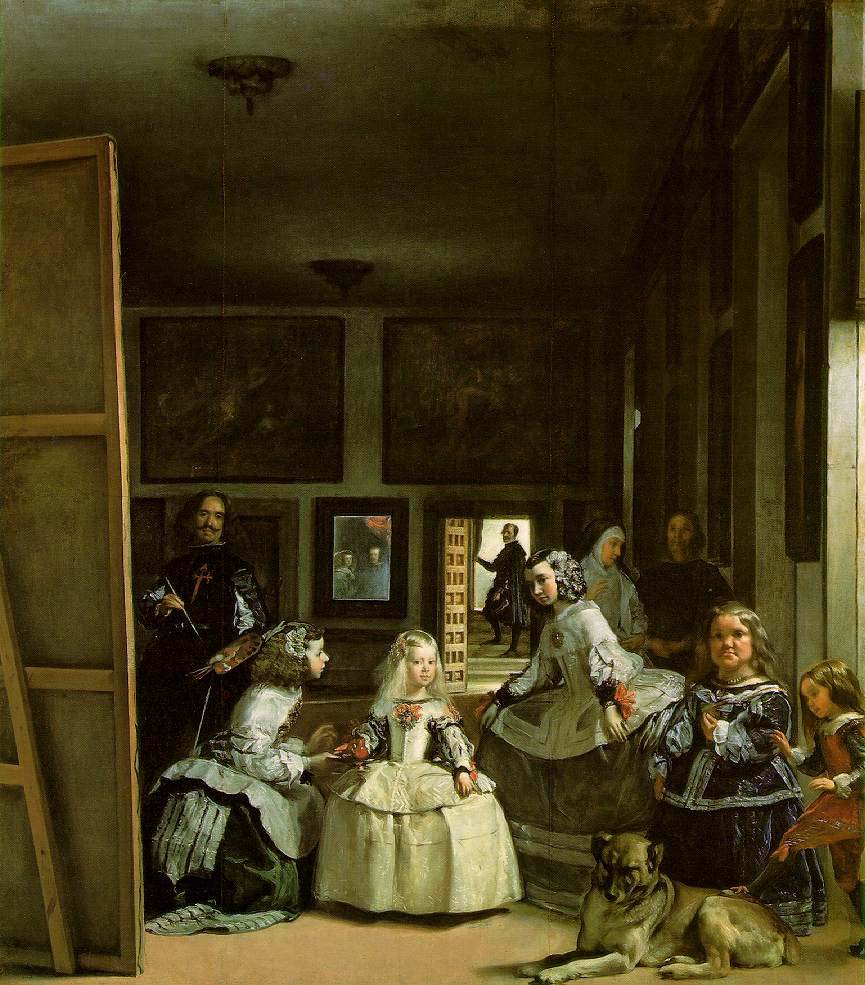
Velázquez's Las Meninas

'Las Meninas' (after Velázquez), 1957 (Museu Picasso, Barcelona)
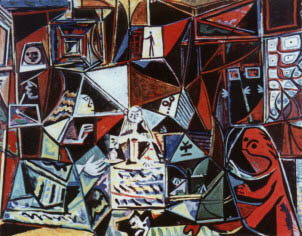
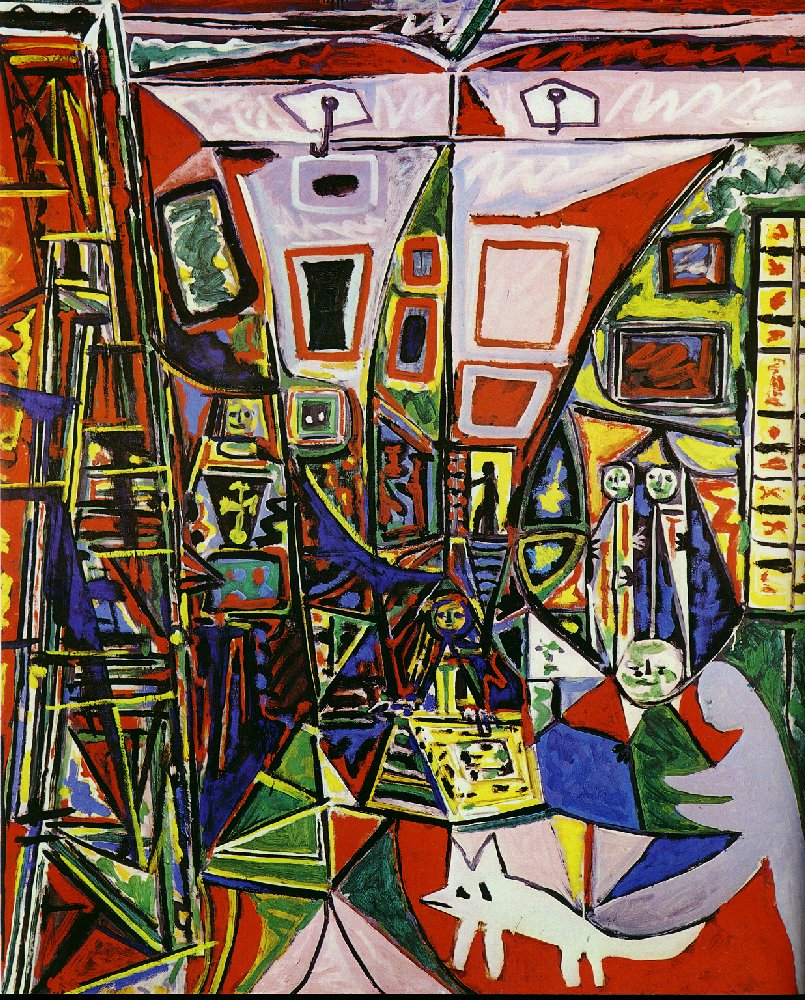


Between August and December 1957, Picasso worked on his variations of Las Meninas (1656), Velázquez’s most important painting. Picasso transformed this masterpiece into an overt accusation of Franco’s regime and royalist policy. His paraphrases have turned out bitter satires aimed at Franco’s monarchist speculations. The royal figures have metamorphosed into caricatures of the present. The numerous variants of the Infanta Margarita Maria refer to the official ‘coming out’ of the Infanta Maria Pilar, Juan Carlos’s sister, an event that was celebrated with a spectacular ball in Estoril in Portugal in 1954. Picasso has changed Velázquez’s self-portrait into that of an inquisitor: even twenty years after the outbreak of the Spanish Civil War, many Republicans were still imprisoned then. Picasso actively supported the Amnesty for Spain campaign and demanded that those held captive be released. In his La Meninas series, he also protested against their inhumane treatment: Picasso’s critical revision depicts the clergymen appearing in Velázquez’s painting murdered and lying in coffins. Picasso has turned the ceiling bosses visible in the original painting into terrifying hooks for the suspension of torture victims.
The Rape of the Sabine Women
Only a few days after the outbreak of the Cuban Missile Crisis in 1962, when President Kennedy announced the naval blockade, Picasso set to work on his series The Rape of the Sabine Women , drawing his inspirations from

Nicolas Poussin’s Rape of the Sabines from 1637/38

and Jacques-Louis David’s The Intervention of the Sabine Women from 1799.

The series The Rape of the Sabine Women, done in autumn 1962, captures the struggle for power between the East and West during the Cuban Missile Crisis. Picasso was well aware of the powerful impact of the ancient myth and saw it as a possibility to respond to and understand the present. Picasso used this series to denounce violence, as he had done in his earlier works, Guernica and The Charnel House. His idea of warfare and its consequences clearly concentrated on the suffering of the victims, in particular women and children: deformed bodies trampled down by soldiers express helplessness and despair.
The Dove – Picasso’s Symbol for Peace and Freedom
Through his dove, which was first to be seen on

the poster for the First International World Peace Congress in Paris in 1949,
Picasso’s art became accessible to millions of people. From then on, the motif was used countless times and http://www.blogger.com/homeappeared on the posters for the peace conferences in Wroclaw, Paris, Stockholm, Sheffield, and Rome. It became the ubiquitous emblem of the Peace Movement and is still one of the most important symbols of hope. The dove adorned scarves, cups, posters, and T-shirts, as well as postage stamps in the Soviet Union and the People’s Republic of China. Picasso supported the Communist Party in France and other countries and radical organizations in the West with numerous variants of the motif. The artist even named his daughter Paloma, after the Spanish word for ‘dove’. By the 1950s, this key motif of his art had become so popular that it was even used as a caricature for anti-Communist propaganda. The New York Times mockingly referred to “Picasso’s fat little pigeons.”
War and Peace

In 1951/52, Picasso, who had been entrusted with the commission by the Communist-governed village of Vallauris in Southern France, worked on his War and Peace murals. They were intended for a deconsecrated palace chapel that was to be transformed into a Temple of Peace. Picasso titled the two monumental compositions after Leo Tolstoy’s Napoleonic epic. They were the artist’s most significant political statements since the end of the Second World War. War and Peace powerfully and impressively demonstrates men’s inherent potentials: they can be beasts and monsters, but also humanists. There are more than two hundred preliminary studies for the chapel at Vallauris. Picasso finally painted the two murals on panels that were attached to two opposite walls of the small church. In 1958, he added another painting to the end wall: four figures in black, white, yellow, and red, symbolizing the harmonious coexistence of the four world races. The chapel at Vallauris was opened in 1958, but closed soon afterwards because of the tensions between Picasso and the rightwing Gaullist government.
Le Déjeuner sur l’herbe
‘Variations’ after
_(1).jpg)
Manet’s 'Le Déjeuner sur l’Herbe',
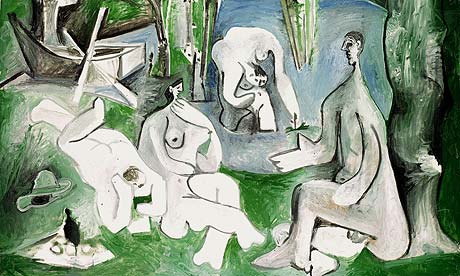


painted between 1960 and 1961 (Musée National Picasso, Paris).
Between 1959 and 1962, Picasso paraphrased Édouard Manet’s famous painting Le Déjeuner sur l’herbe (1863) in numerous paintings, drawings, and prints. Picasso was fascinated both by Manet’s sketchy manner of painting and his unconventional daringness of linking an anti-bourgeois subject with the high ambition of creating a classical composition. In addressing a taboo – the prostitution at the Bois de Boulogne – Manet’s liberal depiction caused a scandal when it was exhibited at the Salon des Refusés in 1863. Picasso’s preoccupation with Manet’s provocative theme is not least an expression of the artist’s sympathetic relationship with the emerging sexual revolution, the hippie movement, and its demand for free love. In France, it was once again the Bois de Boulogne in Paris that was the hotspot of this social revolution. Picasso admired Manet not only as an artist, but also as a committed republican and political activist: Manet had been deeply disappointed about the failure of the Paris Commune in 1871, which had sought to govern Paris according to Socialist ideas and whose suppression had entailed the proclamation of the Third Republic. For Picasso, history repeated itself when in 1958 General de Gaulle put an end to the Fourth Republic, which had been rendered politically weak and unstable through frequent changes of government, and proclaimed the Fifth Republic.
Mothers and Musketeers
The paintings of the last decade of Picasso’s life are dominated by two subjects: women and musketeers. The woman – as an allegory of love and in her roles as mother – is regarded as the epitome of harmony and security, an embodiment of the yearning for peace. In her strong erotic appeal, the woman symbolizes fertility and conception and thus illustrates that life begins with sexual desire. Musketeers, on the other hand, personify militant warriors, eagerly on the lookout for adventure and loot. Picasso depicts them as arrogant soldiers, foppish and ridiculous in their complacent virility. For Picasso, a committed pacifist, the figure of the musketeer was emblematic of war and barbarity, although it was generally associated with a highly positive soldier’s image during the 1950s and 1960s, thanks to Dumas’s novel.
Views of Picasso
In the USA, Picasso’s affiliation with Communism was regarded with great scepticism. It even earned the artist, who was considered a “subversive alien”, a charge from the FBI, which remained pending until his death. In the paranoid America of the McCarthy era, persons associated with Picasso – such as Charlie Chaplin – were eyed with suspicion, and by the 1950s, at the height of the Cold War, Picasso’s reputation had suffered to such an extent that the authorities refused to issue a visa for him when he wanted to travel to the United States for the first time in 1950 in order to attend a peace conference. In the West, Picasso’s works from after 1944, particularly the murals War and Peace, turned out to be the artist’s least successful pictures, whereas they also met with criticism in the East, since they were not in line with the Soviet Communist Party’s call for Social Realism. Between these polarities, Picasso developed his own artistic and political attitude, which he described as follows: “I did not paint the war because I am not one of those artists who go looking for a subject like a photographer, but there is no doubt that the war is there in the pictures which I painted then.”
In many of his works, Picasso overtly promoted the Communist cause and the Peace Movement and protested against war and suppression. Through his oeuvre, he explicitly commented upon the global political crises of his time. His still lifes, his numerous interpretations of themes from classical mythology (such as The Rape of the Sabine Women), and his variations of art historical masterpieces (Velázquez’d Las Meninas and Manet’s Déjeuner sur l’herbe) contain subtle and hidden statements about international events and Picasso’s political beliefs.
Picasso’s membership in the Communist Party from 1944 onwards and the reflection of his political commitment in his work are probably the last quasi-unexplored terrain when it comes to the research into this artist. The exhibition, which was the result of a seven-year scientific project conducted by Dr. Lynda Morris, attempted to make a profound scholarly analysis of the period in question by incorporating views of Picasso from North America, Western Europe, Eastern Europe, and the Russian Federation. Picasso: Peace and Freedom is a comprehensive show which includes masterpieces addressing the subject of the Cold War that were created from the 1940s on. They are complemented by political ephemera and contemporary biographical texts, such as letters, archival documents, publications, and newspapers. While the exhibition deals with Picasso’s global role and art from the perspective of his support of the Communist Party and the Peace Movement in general, the focus of the presentation in Liverpool was on the artist’s visit in Great Britain on the occasion of his participation in the Peace Congress in Sheffield in 1950. Vienna as a town located at the crossroads between the East and West after the Second World War, likewise offers itself as an ideal venue: in 1952 it hosted the World Peace Congress, whose poster showed Picasso’s drawing of a dove surrounded by a circle of interlocking hands. This exhibition, co-organized by Tate Liverpool and the Vienna Albertina, will modify, expand, and probably revolutionize our hitherto common view of Picasso. Within this framework, the artist, who has mostly been perceived as an extrovert and womanizer, appears in a social and cultural context that has previously largely been ignored in the treatment of this painter, whose political side has systematically been shut out.
“No, painting is not done to decorate apartments. It is an instrument of war for attack and defence against the enemy.” (Picasso)
BIOGRAPHY
1881 25 October: Pablo Ruiz Picasso is born in Málaga.
1918 Picasso marries Olga Koklova. Until the outbreak of the Spanish Civil War in 1936, Picasso is largely apolitical, and his work develops independently of contemporary political events. The artist, due to his invention of Cubism and his return to Classicism in the 1920s, becomes the leading pioneer of Modernism.
1936 In recognition of Picasso’s opposition to Franco’s takeover, the Republicans appoint the artist director of the Prado.
1937 26 April: Bombardment of the Basque town of Guernica. In response, Picasso creates his painting of the same name, which becomes a worldwide anti-war symbol. Mid-June: Guernica is presented at the Spanish Pavilion of the Paris World Fair.
1940 14 June: Picasso turns down invitations from the US and other countries to flee from occupied France. He assists the resistance movement whilst in voluntary exile. 25 August: Threatened by the presence of German troops in Royan, Picasso returns to Paris for the duration of the war. Autumn: A German officer, seeing a photograph of Guernica in Picasso’s studio, asks the artist: “Did you do this?” – “No,” Picasso replies, “You did.”
1944 August: After the liberation of Paris, Picasso, as the leading practitioner of an art condemned by the Fascists, becomes a celebrated hero. For weeks afterwards, he receives visits in his studio from young writers, photographers, artists, intellectuals, and GIs. 5 October: The Communist daily newspaper L’Humanité announces Picasso has joined the French Communist Party (PCF). He believes that Communism offers a path away from the Fascist atrocities of the Second World War and the Spanish Civil War. 7 October: Anger at Picasso’s political beliefs leads to protests by right-wing groups at this year’s opening of the Salon d’Automne in Paris, also known as the Salon de la Libération. Many are outraged that the Salon is exhibiting a Spaniard’s work only a few weeks after the liberation of France. 16 October: A procession takes place to the Père Lachaise cemetery in order to honour the victims of the Résistance. Picasso and Paul Éluard attend, marching under the flag of the Front national universitaire.
1945 February–May: Picasso completes The Charnel House. It is based on a Spanish documentary film in which a Republican family is annihilated in its kitchen. 23 May: Picasso draws Maurice Thorez (1900–1964), Secretary General of the PCF. June: The PCF pays tribute to Picasso at its Tenth Congress, but reaffirms its call for realism in art. End of year: Begins Homage to the Spaniards, a patriotic composition.
1946 July: Picasso moves into the upper floor of the Antibes Museum on the Côte d’Azur. He cares for a wounded owl, an animal that is soon to appear in a series of still lifes as a symbol of death.
1947 August: Picasso begins making ceramics in Vallauris (near Nice), at the Madoura pottery.
1948 Picasso assists the protests of the veterans of the Abraham Lincoln Brigade, the US division of international brigades in the Spanish Civil War. 23–28 August: Picasso takes part in the Peace Congress in Wroclaw, Poland. He issues a public declaration supporting the persecuted Chilean Pablo Neruda and visits the Auschwitz concentration camp, where he receives a medal from the Polish president. October: Picasso donates a million (old) francs to the miners’ strike in Northern France.
1949 February: Louis Aragon visits Picasso’s studio and selects the lithograph of a dove (created on 9 January) whose image is used on the poster for the World Peace Congress in Paris. The image becomes known worldwide as the Dove of Peace. 19 April: Birth of Françoise Gilot and Picasso’s daughter Paloma (Spanish for ‘dove’). 20–23 April: Picasso attends the World Peace Congress in Paris. 28–31 October: Picasso attends the World Peace Congress in Rome.
1950 29 January: The Communist town council of Vallauris bestows honorary citizenship on Picasso. March: Picasso is one of twelve Partisans of Peace selected to present the fifty million signatures of the Stockholm Peace Appeal against Atomic Weapons to the US Congress in Washington. He is refused a visa to enter the US. November: Picasso is awarded the Prize of the World Peace Congress, which he shares with Paul Robeson (1898–1976) and Pablo Neruda (1904–1973).
1951 18 January: Picasso starts work on Massacre in Korea, an overt political statement about the US military intervention in Korea. 1952 Outraged by the Korean War, Picasso decides to decorate a deconsecrated chapel in Vallauris with two wall paintings to be arranged opposite each other; one depicts War, the other, Peace.
1954 November: Shortly after the outbreak of the Algerian War of Independence, Picasso begins working on the series The Women of Algiers.
1955 Summer: Picasso purchases the Villa La Californie above Cannes. 1956 25 October: Picasso’s 75th birthday is celebrated at the Madoura pottery. Soviet state-owned works by Picasso are shown in exhibitions organized by Ilya Ehrenburg in Moscow and Leningrad (today’s St. Petersburg). November: Picasso is one of ten Communist artists and intellectuals who in an open letter to Le Monde express profound anxiety about the suppression of the Hungarian Revolution. They denounce the PCF’s silence and demand clarification from the party’s Central Committee.
1957 May: A major retrospective is held at New York’s Museum of Modern Art, which subsequently tours to the Art Institute of Chicago and the Philadelphia Museum of Art. Because of Picasso’s association with Communism it is impossible to invite the artist to the US. August: Picasso begins working on the Las Meninas series (based on Velázquez). It reveals the artist’s dialogue with one of the most important works in the history of Spanish painting and at the same time is a critical comment on current political events under Franco’s regime in Spain. Autumn: Commissioned by the UNESCO, Picasso designs a mural for the organization’s Paris headquarters.
1959 Picasso becomes involved with the launch of an international amnesty campaign against the continuing imprisonment of Republicans in Franco’s Spain. August: Picasso begins his variations on Édouard Manet’s Le Déjeuner sur l’herbe (until 1962).
1961 2 March: Picasso marries Jacqueline Roque in Vallauris. 25 October: Picasso’s 80th birthday, celebrations at Vallauris three days later.
1962 The Soviet government awards Picasso the International Lenin Prize for Peace. Autumn: Only ten days after the outbreak of the Cuban Missile Crisis, Picasso starts working on the series The Rape of the Sabine Women and his belligerent lobster and cat scenes.
1965 Picasso becomes ill and travels to Paris for an ulcer operation. It is his last trip there.
1966 A Picasso exhibition at the Pushkin Museum in Moscow is organized with the aid of Ilya Ehrenburg.
1967 Picasso refuses to join the French Legion of Honour.
1968 23 March: Picasso sends a written statement of solidarity to the Day of the Intellectuals for Peace in Vietnam. Mid-November 1968: Picasso provides his drawing Physiognomy of War as a motif to be used on the poster for the March to Washington, organized by American anti-Vietnam activists.
1971 An exhibition is staged at the Louvre to honour Picasso on the occasion of his 90th birthday.
1973 8 April: Picasso dies in Mougins.